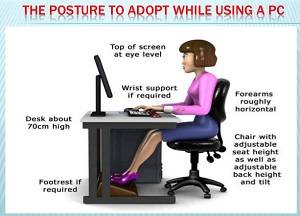Working with Computers Health and Safety
Nowadays, there are few jobs that do not involve using computers or some kind of visual display unit (VDU).
It is part and parcel of working in a modern world of information technology and digital communication.
Most workers who use a computer as part of their job will suffer no serious ill-effects.
Modern VDUs do not give off harmful levels of radiation. Thus, it would be very uncommon to get a skin complaint from using a VDU.
If you do suffer ill-effects after using a computer it is most likely because of the way you use it. Some of the most common problems include minor aches and hand strains.
It would not be uncommon to suffer from a strain in the back of the hand or index finger. In most cases it would be due to excessive mouse-clicking.
Whereas, suffering a neck pain can occur after using a VDU for a long time or without proper rest breaks at work. You can help to avoid computer use problems by using a well-designed workstation.
Employer Obligations Computers
According to the health and safety regulations on display screen equipment in the United Kingdom, employers should:
- Assess VDU workstations and reduce any of the risks identified in the assessment.
- Ensure that all computer workstations meet the relevant safety requirements.
- Plan staff workloads so that they get regular breaks or changes to the type of work they do.
- Arrange for an eye test if any of the staff using computers need to get tested.
- Provide staff members with health and safety training. This should include any appropriate information on safe computer use at work.
Note: A computer health and safety at work guide also applies to employees who work at home. Thus, follow the safe computer regulations when using a VDU over a long period of time. Report any concerns to your employer.
Taking Breaks from Computer Screen
 Employees should take regular breaks from computer work. But, there is no statutory legal limit on how long workers should be working at a VDU.
Employees should take regular breaks from computer work. But, there is no statutory legal limit on how long workers should be working at a VDU.
Even so, health and safety at work rules provide certain rights on safe computer use. Staff can take breaks while working on display screen equipment.
Thus, if you are employing workers, you must allow them to do different types of work to create a break (if not a rest break).
General guidance on using computers at work comes from the Health and Safety Executive (HSE). They suggest that shorter breaks – taken more often at the workstation – are better than longer breaks that are less frequent.
Note: Try to take a 5 to 10 minute break after each continuous hour worked at a screen or keyboard.
Certain jobs mean spending long periods staring at a VDU (e.g. inputting data). If this is your role, try to get your employer to introduce longer breaks from the workstation.
Proper Sitting Position in Front of Computer
You should be sitting in a comfortable position when working at a Visual Display Unit. Some tips for adopting the best position to sit while working at a computer include:
- Set the desk around 70cm high and keep a good sitting posture for your back, neck, and legs.
- Use a chair with height adjuster, adjustable back height, and tilt mechanism.
- Position the seat so that your eyes are level with the screen.
- Ensure there is enough space to sit as comfortable as possible with your forearms in a horizontal position.
- Avoid sitting in the same position for too long.
- Use a footrest and wrist support (if needed).
Employers have a duty to make ‘reasonable adjustments‘ for you if you are disabled. As a rule, it means providing special computer equipment or making alterations to suit your individual needs.
Employee Right to Free Eye Tests
Health studies have yet to show a real link between VDU use and eyesight damage. But, there are steps you can take if you feel that using a VDU screen makes your eyes tired.
The first step is to inform either your employer or an employee safety representative. As a rule, employees who use a VDU during working hours have the right to a free eyesight test.
An optician may prescribe wearing glasses to help workers who use display screen equipment. If so, the employer has a responsibility to pay for a basic pair of glasses if they are ‘especially’ needed for work.
Note: If an optician recommends it, you may qualify to get extra eye tests carried out on a regular basis.
Health Problems Caused by Computer Screens
Your employer must assess the risks involved with your job. They should pay special attention to safe computer use in the workplace. Part of that includes making sure the desks and equipment are comfortable for use. Inform your employer if you need any special equipment (e.g. a footrest or wrist rests).

